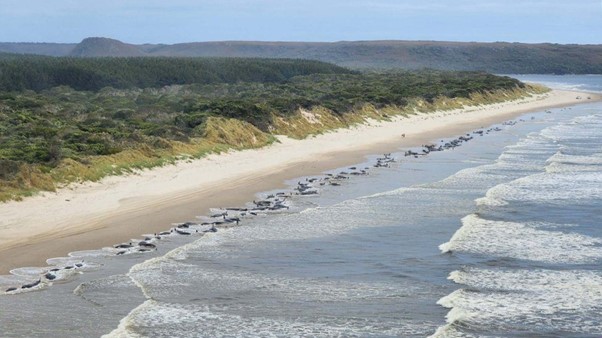You may have seen in recent news the devastating mass stranding events occurring in New Zealand and Tasmania within the past month. In a space of only three weeks and in three separate instances, a total of approximately 700 pilot whales were washed up ashore (McClure, 2022). Cetacean strandings are no new phenomenon and have been long recorded throughout history (Sousa and Brito, 2012), with thousands of whales, dolphins and porpoises being washed ashore globally each year (Hobson, 2021). Despite widespread rescue efforts, sadly these events often result in multiple fatalities. However data suggests numbers have been on the rise in recent years (Alvarado-Rybak et al., 2020), so what causes these animals to show up on our shorelines, and how can we mitigate the problem?
What are strandings?
‘Stranding’ or ‘beaching’ refers to the event in which cetaceans are washed up on shore, either live or deceased (Hobson, 2021). Often relative to species type and geographical location, these events can involve solitary or mass strandings and can rapidly place the animals lives at great risk, often resulting in low survival rates (Hobson, 2021). While mass strandings of this extent are less common here in the UK, countries such as New Zealand and Tasmania are much more familiar with such events, seeing multiple instances of up to hundreds of animals washed up at one time.
While these events can be distressing, strandings data can provide an important insight into not only the relative abundance and health of a species, but also the wider health of the ocean (Coombs et al., 2019). Due to the wide ranging and inaccessible nature of cetaceans, this can be a challenging area to study, but vital in making important conservation decisions (Clarke et al., 2021; Coombs et al., 2019). These events are monitored by multiple long term global datasets such as the UK Cetacean Strandings Investigation Programme (CSIP), in order to gather important data in determining why and where these strandings are occurring.
Why do they happen?
Cetacean strandings are thought to occur due to a number of factors and are primarily due to natural, environmental and anthropogenic causes. Naturally occurring factors could be that the animal is simply reaching the end of its lifespan due to old age and is ultimately washed up on shore by prevailing winds (Hobson, 2021). However, many strandings involve healthy animals that are negatively impacted by disorientation, physical injury, and the redistribution of prey that navigates them away from deeper and safer waters (Coombs et al., 2019). When cetaceans find themselves in shallower waters, they subsequently get trapped on land and have a limited chance of survival (Brownlow et al., 2020).
Anthropogenic causes
The physical health of cetaceans can be heavily impacted by anthropogenic activities. Prime examples include ship strikes, bycatch entanglement, decompression sickness caused by military sonar activities and toxic contamination from ingestion of anthropogenic waste (Coombs et al., 2019). Overfishing and rising ocean temperatures as a result of climate change can also vastly impact the distribution of their prey, potentially leading to starvation or influencing their direction of travel putting them further at risk of danger (Coombs et al., 2019). These factors can effectively cause disorientation, injury, poor health, exhaustion and malnourishment (Coombs et al., 2019).
Environmental causes
Cetacean strandings can also be negatively impacted by environmental factors. For example, both geomagnetic and meteorological storms are thought to cause disorientation or injury to cetaceans (Coombs et al., 2019). Furthermore, coastline characteristics can play a significant role in strandings, dependent on the topographic and bathymetric features of a coastline (Brownlow et al., 2020; Evans, 2018). Examples such as shallow bays, channels and sand banks with receding tides can cause cetaceans to get disorientated and trapped. Coastline features are often the reason behind ‘stranding hotspots’ (Brownlow et al., 2020; Evans, 2018) suggesting why such events may reoccur in the same areas.
Mass strandings
As many cetacean species are known to be social creatures, they often swim in small to very large pods. Pilot whales in particular are highly social creatures and a species very prone to mass strandings (Brownlow et al., 2020). Swimming in tight knit pods of anywhere up to figures in the hundreds, pilot whales are also known to follow a leader in the group (Brownlow et al., 2020). Furthermore, the species specifically rely on echolocation to forage (Evans, 2018) and are known to follow prey towards continental shelves and coastal waters which can cause disorientation (Brownlow et al., 2020). If the leader or another member of the pod were to become disoriented or injured and begin heading towards shallower waters, the rest of the loyal pod are likely to follow; subsequently causing mass stranding events (Brownlow et al., 2020).

What to do if you see a stranded cetacean
When discovering a stranded cetacean it needs to be reported immediately as their chance of survival rapidly decreases the longer they are on shore (Hobson, 2021). A stranded cetacean faces a substantial risk of severe dehydration and drowning, if any water enters their blowhole during high tides (Hobson, 2021). As they are usually supported by water, they can also suffocate under their own weight and be poisoned by the build up of toxins in their body, proving fatal for the animal (Hobson, 2021).
The British Divers Marine Life Rescue is an organisation that deals with stranded and injured marine life around the UK. The charity trains volunteers to correctly and safely handle the strandings of seals, whales, porpoises and dolphins who are then called out to the scene to help when a member of the public notifies the rescue hotline (BDMLR, no date). Attempting to help the animal without professional assistance or training puts you and the animals safety at great risk.
How can we help?
While cetacean strandings are inevitable due to natural and environmental factors, the increase in anthropogenic pressures are likely to correlate with a subsequent rise in stranding events (Coombs et al., 2019). Approaches we can all take to avoid exacerbating such events can include; reducing our carbon footprint, cutting down on plastic waste, refraining from supporting overfishing practices, and signing petitions on organisations such as change.org that encourage a solution to issues of concern, such as the harmful consequences of noise pollution and ship strikes.

Volunteering with organisations such as BDMLR can help by expanding their network of volunteers to aid in stranding events around UK coastlines and educating the public on how best to deal with these events when they arise. Furthermore, volunteering with other marine conservation organisations such as the Sea Watch Foundation can contribute to ongoing cetacean research and education, to provide more awareness and further insight into issues related to these events.
BDMLR Rescue hotline: 01825765546
www.bdmlr.org.uk
Find out more about volunteering positions and the work that we do at www.seawatchfoundation.org.uk
Rachael Anderson Feature Blogger References About BDMLR (no date), British Divers Marine Life Rescue. Available at: https://bdmlr.org.uk/about-bdmlr (Last Accessed: 10/10/2022). Alvarado-Rybak, M., Toro, F., Esco-Dodero, J., Kinsley, A.C., Sepulveda, M.A., Capella, J., Azat, C., Cortes-Hinojosa, G., Zimin-Veselkoff, N. and Mardones, F.O. (2020) ’50 Years of Cetacean Strandings Reveal a Concerning Rise in Chilean Patagonia’ Scientific Reports, 10 (9511). Brownlow, A., Baily, J., Dagleish, M., Deaville, R., Foster, G., Jensen, S., Krupp, E., Law, R., Penrose, R., Perkins, M., Read, F. and Jepson, P. (2020) ‘Investigation into the long-finned pilot whale mass stranding event, Kyle of Furness, 22nd July 2011’, SRUC Wildlife Unit. Clarke, P.J., Cubaynes, H.C., Stockin, K.A., Olavarria, C., Vos, A., Fretwell, P.T. and Jackson, J.A. (2021) ‘Cetacean Strandings From Space: Challenges and Opportunities of Very High Resolution Satellites for the Remote Monitoring of Cetacean Mass Strandings’, Frontiers in Marine Science, 1448. Coombs, E.J., Deauville, R., Sabin, R.C., Allan, L., O’Connell, M., Berrow, S., Smith, B., Brownlow, A., Ten Doeschate, M., Penrose, R., Williams, R., Perkins, M.W., Jepson, P.D. and Cooper, N. (2019) ‘What can cetacean stranding records tell us? A study of UK and Irish cetacean diversity over the past 100 years’, Natural History Museum. Evans, G. (2018) ‘New Zealand whales: Why are so many getting stranded?’, BBC News. Available at: https://www.bbc.co.uk/news/world-asia-46400957 (Last accessed: 08/10/2022). Hobson, M. (2021) ‘Why do whales beach themselves? We’re partially to blame.’, National Geographic. Available at: https://www.nationalgeographic.com/animals/article/why-do-whales-beach-themselves (Last accessed: 12/10/2022). Long-finned pilot whale (no date) Whale and Dolphin Conservation. Available at: https://uk.whales.org/whales-dolphins/species-guide/long-finned-pilot-whale/ (Last accessed: 10/10/2022). McClure, T. (2022) ‘Second mass stranding means 500 pilot whales likely to die on remote New Zealand islands’, The Guardian. Available at: https://www.theguardian.com/environment/2022/oct/10/second-mass-stranding-means-500-pilot-whales-likely-to-die-on-remote-new-zealand-islands (Last accessed: 13/10/2022). Sousa, A. and Brito, C. (2012) ‘Historical strandings of cetaceans on the Portuguese coast: anecdotes, people and naturalists’ Cambridge University Press. Whale stranding: 230 whales stranded on Tasmanian Beach (2022) BBC News. Available at: https://www.bbc.co.uk/news/world-australia-62976749 (Last accessed: 09/10/2022).

























